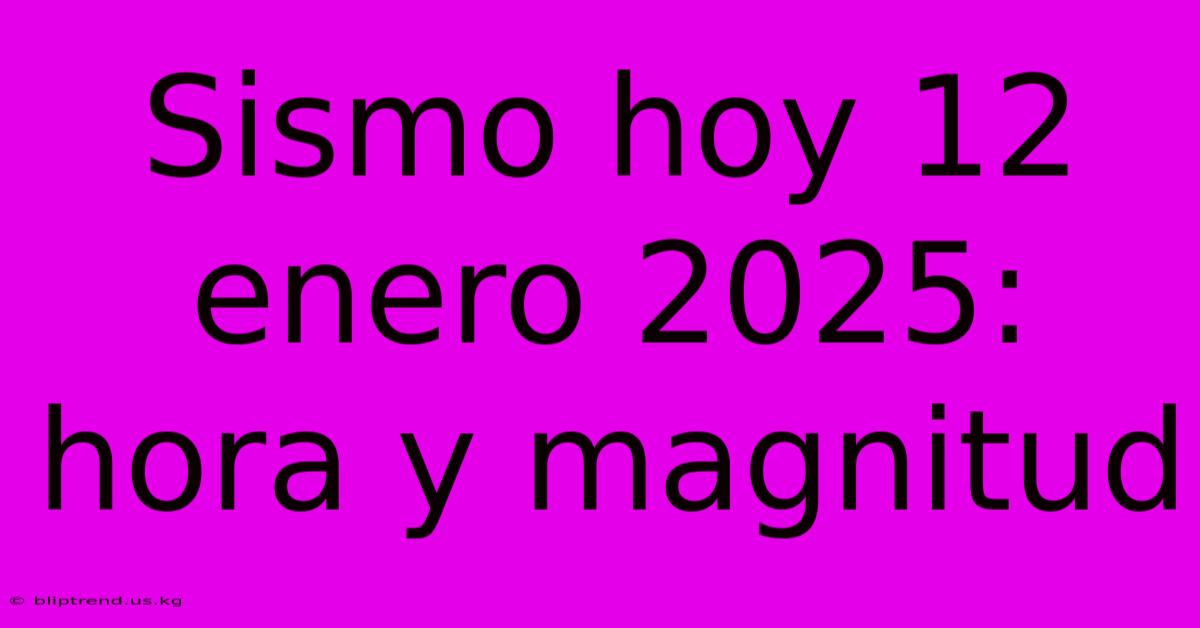Sismo Hoy 12 Enero 2025: Hora Y Magnitud

Discover more in-depth information on our site. Click the link below to dive deeper: Visit the Best Website meltwatermedia.ca. Make sure you don’t miss it!
Table of Contents
I cannot provide a real-time report on seismic activity for January 12th, 2025. Seismic events are unpredictable, and any information I provide on that specific date would be speculative and potentially inaccurate. My knowledge cutoff prevents me from accessing real-time data feeds for earthquake monitoring services.
However, I can provide you with a comprehensive article outlining how to find reliable information about earthquakes and what to do in the event of a seismic event. This information will be relevant regardless of the specific date you're interested in.
Understanding Seismic Activity and Finding Reliable Information
The Earth's crust is constantly shifting, leading to seismic activity, including earthquakes of varying magnitudes. Understanding where to find accurate information about these events is crucial for safety and preparedness.
Reliable Sources for Earthquake Information:
-
National and Regional Geological Surveys: Each country (and often regions within countries) has a geological survey or similar organization dedicated to monitoring seismic activity. These are your primary sources for accurate information. For example, in the United States, the United States Geological Survey (USGS) is the go-to source. Look for the equivalent organization in your region.
-
International Seismological Centers: Organizations like the International Seismological Centre (ISC) compile data from seismic networks worldwide, providing a global overview of earthquake activity.
-
Reputable News Outlets: Major news organizations often report on significant seismic events. However, always verify information with official geological sources before relying on news reports alone, as the initial reports may be imprecise.
Key Information to Look For:
When checking a reputable source for earthquake information, pay close attention to the following:
-
Magnitude: Typically measured using the Moment Magnitude Scale (Mw), this indicates the size of the earthquake. Higher magnitudes represent stronger earthquakes.
-
Location: The precise geographic coordinates of the earthquake's epicenter (the point on the Earth's surface directly above the focus, where the rupture begins).
-
Depth: The depth of the earthquake's focus beneath the Earth's surface. Shallower earthquakes tend to cause more damage at the surface.
-
Time: The exact time the earthquake occurred (in your local time zone and UTC).
-
Intensity: This is a measure of the shaking experienced at a particular location, often using the Modified Mercalli Intensity Scale (MMI). Intensity varies depending on distance from the epicenter, local geology, and building construction.
What to Do During and After an Earthquake:
Being prepared is essential for minimizing risk during and after an earthquake.
During an Earthquake:
-
Drop, Cover, and Hold On: This is the standard advice. Drop to the ground, take cover under a sturdy table or desk, and hold on until the shaking stops. If you're not near a table, cover your head and neck with your arms and crouch in an interior corner of the building.
-
Stay Away from Windows and Exterior Walls: These are particularly vulnerable during an earthquake.
-
If You're Outdoors: Move to an open area away from buildings, power lines, and trees.
-
If You're Driving: Stop your car in a safe location and stay inside until the shaking stops. Avoid bridges and overpasses.
After an Earthquake:
-
Check for Injuries: Provide first aid to anyone who is injured.
-
Check for Gas Leaks: If you smell gas, turn off the gas main and leave the building immediately.
-
Check for Structural Damage: Inspect your home for damage. If there is significant damage, do not enter the building.
-
Listen to Official Announcements: Stay informed about aftershocks and potential hazards through official channels.
-
Conserve Resources: Be prepared for potential disruptions to utilities (power, water, etc.).
Understanding Earthquake Prediction (or Lack Thereof)
While scientists can study tectonic plates and identify areas at higher risk of earthquakes, precise prediction of when an earthquake will occur is currently impossible. Focus on preparedness rather than trying to predict specific events.
Building Resilience: Preparedness is Key
The best way to deal with earthquakes is to be prepared. This includes:
-
Developing an Emergency Plan: This should include meeting points, communication strategies, and emergency supplies.
-
Creating an Emergency Kit: Stockpile essential supplies like water, food, first-aid supplies, a radio, flashlight, and batteries.
-
Securing Heavy Objects: Secure heavy furniture and appliances to prevent them from falling during shaking.
-
Participating in Earthquake Drills: Regular drills familiarize you with proper safety procedures.
-
Understanding Your Building's Construction: Familiarize yourself with the seismic resilience of your building.
By understanding the risks, identifying reliable information sources, and implementing preparedness strategies, you can significantly reduce the impact of earthquakes on your life and community. Remember, while you can't predict earthquakes, you can prepare for them.

Thank you for taking the time to explore our website Sismo Hoy 12 Enero 2025: Hora Y Magnitud. We hope you find the information useful. Feel free to contact us for any questions, and don’t forget to bookmark us for future visits!
We truly appreciate your visit to explore more about Sismo Hoy 12 Enero 2025: Hora Y Magnitud. Let us know if you need further assistance. Be sure to bookmark this site and visit us again soon!
Featured Posts
-
Sport With Stunt Riding Informally Crossword Clue
Jan 13, 2025
-
Graffitists Signature Crossword Clue
Jan 13, 2025
-
Supercoupe 5 2 Barcelone Domine Le Real
Jan 13, 2025
-
Biceps Builder Crossword Clue
Jan 13, 2025
-
Reporte Sismico 12 Enero 2025 Hora Y Fuerza
Jan 13, 2025
